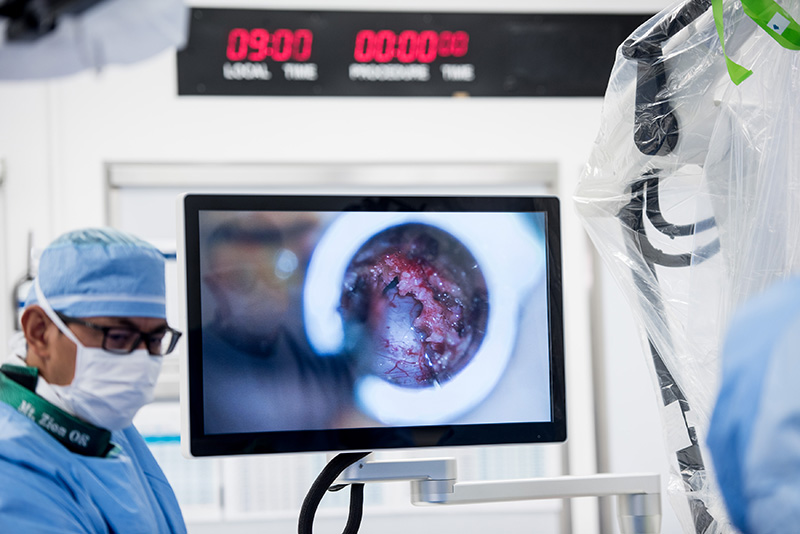At 8:30 AM, in a large operating room at UCSF’s Mt. Zion campus, neurosurgeon Aaron Clark, MD, PhD, made the first of two tiny incisions for a L3/4 minimally invasive laminoforaminotomy with bilateral decompression. His patient, a 57-year-old woman, had undergone a lumbar fusion at another hospital six years prior and developed adjacent-level stenosis that was causing bilateral leg pain, numbness, and tingling.
“She had tried epidural steroid injections and pain medications, yet her pain was still debilitating,” said Clark. “Her symptoms were due to stenosis at a single level, but I will treat up to four levels minimally invasively.”
Peering through a microscope he began working through a tube just 16-mm in diameter – about the width of a thumb – to relieve compression of the spinal nerve roots. By 10:15 AM the patient was being transferred to postoperative care, and an hour later she was on her way home.
“The traditional approach would have been a standard open L3/4 laminoforaminotomy, which involves stripping muscle off of the spine to gain the required exposure,” said Clark. “The most important part of minimally invasive surgery is dilating between muscle fibers to preserve as much muscle as possible.”
In addition to procedures like laminoforaminotomies and microdiscectomies for the lumbar spine, a variety of minimally invasive options also exist to treat the cervical spine. A cervical posterior foraminotomy, for example, is a minimally invasive procedure that can be done to remove bone and/or portions of a diseased or herniated disc, relieving neck and arm pain.
“The procedure is designed to enlarge the space avoiding the need for a fusion to be performed,” said orthopedic surgeon Bobby Tay, MD, who specializes in both minimally invasive cervical surgery and complex cervical reconstruction. “This can often be done as an outpatient procedure and patients typically do not require a neck collar after the surgery.”
While Tay points out that the ideal candidates for minimally invasive cervical procedures are those with very focused problems at one or two levels, the continuous refinement of minimally invasive techniques and instrumentation now allows for correction of even significant scoliosis.
“Recovery time is considerably less using minimally invasive anterior and staged posterior surgery to correct spinal deformity,” said neurosurgeon Praveen Mummaneni, MD, co-director of the UCSF Spine Center. “There is less blood loss and less postoperative pain, and often patients having minimally invasive deformity surgery can avoid the intensive care unit.”
These factors are especially attractive for older patients who in the past were not considered surgical candidates because of the risks associated with large operations. “The minimally invasive spinal deformity surgery algorithm can be helpful in selecting the most appropriate type of surgical approach for each patient,” said Mummaneni. Published in Neurosurgical Focus in 2014, this algorithm gives spine surgeons a decision-making framework to use when considering minimally invasive or open surgery.
